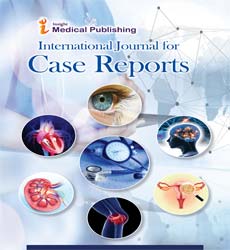Cutaneous Presentations in Children with Cancer.
Theclar Iyidobi*
Department of Psychological Medicine, University of Nigeria Teaching Hospital, Enugu, Nigeria
- *Corresponding Author:
- Theclar Iyidobi
Department of Psychological Medicine
University of Nigeria Teaching Hospital
Enugu
Nigeria
E-mail: trezngbo@yahoo.com
Received Date: May 10, 2021; Accepted Date: September 02, 2021; Published Date: September 14, 2021
Citation: Iyidobi T (2021) Cutaneous Presentations in Children with Cancer. Int J Case Rep Vol.5 No.5.
Abstract
Every year, 300,000 new cases of cancer are diagnosed in children and adolescents under the age of 19 around the world (World Health Organization, 2020). Every year in the United States, over 11,000 children under the age of 14 are diagnosed with cancer for the first time. Both their primary malignancies and chemotherapeutic agents can cause dermatologic manifestations in pediatric oncology patients. To increase symptom control and contact between the child and the clinician, a range of mobile health apps have been created for use with pediatric oncology patients.
Introduction
Every year, 300,000 new cases of cancer are diagnosed in children and adolescents under the age of 19 around the world (World Health Organization, 2020). Every year in the United States, over 11,000 children under the age of 14 are diagnosed with cancer for the first time. Both their primary malignancies and chemotherapeutic agents can cause dermatologic manifestations in pediatric oncology patients. To increase symptom control and contact between the child and the clinician, a range of mobile health apps have been created for use with pediatric oncology patients.
Most of the time, these symptoms are linked to chemotherapeutic agents, which cause a variety of mucosal manifestations. Both their primary malignancies and chemotherapeutic agents can cause dermatologic manifestations in pediatric oncology patients. Most of the time, these symptoms are linked to chemotherapeutic agents, which cause a variety of mucosal manifestations.
Patients with cancer have a variety of skin symptoms that are linked to their main disease and treatments. Despite the fact that these skin toxicity effects have been well documented in adults, research on pediatric oncology patients is minimal. The aim of this research was to look at the cutaneous results in children who were undergoing chemotherapy for cancer. One of the most common therapies for cancer patients is chemotherapy. Chemotherapy can have side effects in children with cancer, in addition to its therapeutic effects. Chemotherapy and its side effects may have an impact on children with cancer, particularly those who need frequent hospitalizations and who have had negative experiences with the treatments.
In this regard, the current study's aim was to look into the connection between family support and the quality of life of children with cancer after chemotherapy. This was a crosssectional analysis with a descriptive–correlational style. A total of 30 children were included in the current study's sample. In cancer patients, chemotherapy treatment often induces side effects such as fatigue. Depression can be caused by cancer treatment and diagnosis, and it plays a role in fatigue pathophysiology. Depression can lead to inflammatory changes in the body, which can lead to fatigue. The aim of this study is to provide a broad overview of the impact of nursing-based expertise on the energy conservation model in coping with nutritional issues in cancer children. The nursing care method is used in a case study of five paediatric patients. Centered on the domains of energy efficiency, structural integrity, and penetrability, the evaluation was carried out using Levine's Conservation Model. 3D photography may be used to identify variations in face shape between people. Previous studies used 3D facial photography to detect increased facial asymmetry and greater variance from standard facial morphology in a group of people with distinct morphological features who had childhood cancer versus healthy controls. Among the currently available anticancer agents, ionizing radiation is unusual in that the dose can be precisely titrated and modulated in space and time. The occurrence of adverse effects is strongly linked to both timedose- fractionation and the spatial distribution of dose. Chemotherapy is one of the most common diseases for cancer patients. Chemotherapy can have side effects in children with cancer, in addition to its therapeutic effects. Chemotherapy and its side effects may have an impact on children with cancer, particularly those who need regular hospitalizations and who have had negative experiences with the therapies.
References
- Abbasi S (1999) "Aspergillosis in children with cancer: a 34-year experience." Clinical infectious diseases 29: 1210-1219.
- Boccara O (2012) "Cutaneous hematologic disorders in children." Pediatric blood & cancer 58: 226-232.
- Morren MA (2016) "Diverse cutaneous presentations of Langerhans cell histiocytosis in children: a retrospective cohort study." Pediatric blood & cancer 63: 486-492.
- Réguerre Y (2016) "Cutaneous malignant melanoma in children and adolescents treated in pediatric oncology units." Pediatric blood & cancer 63: 1922-1927.
- Muljono A, Nicole SG, Susan A (2009) "Primary cutaneous lymphoblastic lymphoma in children: series of eight cases with review of the literature." Pathology 41: 223-228.
Open Access Journals
- Aquaculture & Veterinary Science
- Chemistry & Chemical Sciences
- Clinical Sciences
- Engineering
- General Science
- Genetics & Molecular Biology
- Health Care & Nursing
- Immunology & Microbiology
- Materials Science
- Mathematics & Physics
- Medical Sciences
- Neurology & Psychiatry
- Oncology & Cancer Science
- Pharmaceutical Sciences
